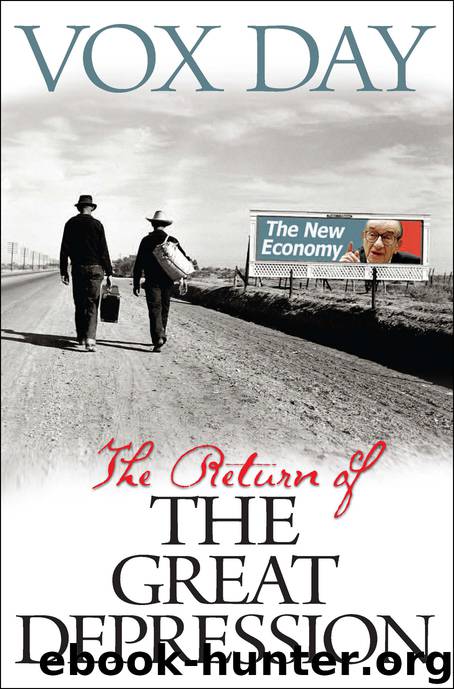The Return of The Great Depression by Vox Day

Author:Vox Day
Language: eng
Format: epub, mobi
Publisher: Wnd books
Published: 2009-08-20T16:00:00+00:00
Figure 7.1. The Limits of Demand
It must be understood that this is very different from the Keynesian concept of underconsumption. There is no shortage of consumption, in fact, the problem is rooted in the credit-based creation of demand in consumers that could not otherwise afford to be buying the consumer goods they are purchasing. It should be obvious that in the real world of economic scarcity and finite resources, there will always be material limits on consumption.144 Once the artificially enhanced demand limits are reached, or even worse, consumers cannot afford to service their debt on the goods they previously purchased, the boom will come to a hard and fast end. It is important to understand that this is not a fluctuation limited to a single market, it is merely the way in which the general expansion of credit plays out in all of the specific markets to which the credit expansion is directed. The focus on the aggregate economy should not blind us to the fact that the distribution of credit is never uniform throughout the entire economy.
Consider a hypothetical example of an economy in which there are 100 cars being driven every year. Assume that a car lasts for ten years, while every year 10 cars wear out and are replaced. The economy is healthy, people are getting wealthier, and so five households buy second cars. Ten cars wear out, the three car makers each sell five cars, which represents half their maximum productive capacity, and now there are 105 cars in the economy. In the second year, however, there is a brief stock market panic due to the failure of the cashew harvest in Madagascar, so the central bank gets nervous and slashes interest rates. The credit expansion begins, and one sector in which it is focused is the car industry. The auto makers are seeking to expand their market, which they do by taking advantage of the cheap credit to provide inexpensive leases that will allow those who don’t have the purchase price of a car to buy one. These leases are so affordable that twenty more households decide to buy second cars. Ten cars wear out and are replaced, so there are now 125 cars in the economy. The car manufacturers are now running at their full capacity of 10 cars apiece, so in order to keep up with the growing pace of demand, each year they invest in new capital goods that allow them to produce 5 additional cars apiece. Pleased by the wealth-creating results of its actions and leery of any action that might bring an end to this period of prosperity, the central bank keeps rates low, consumers continue to take advantage of the inexpensive car-financing offers, and three years later there are 275 cars in an economy that five years earlier required only 100. Instead of 1 vehicle per household, there are now 2.75 cars in every garage and driveway, which is getting perilously close to the maximum number that the members of the various households either want or need.
Download
The Return of The Great Depression by Vox Day.mobi
This site does not store any files on its server. We only index and link to content provided by other sites. Please contact the content providers to delete copyright contents if any and email us, we'll remove relevant links or contents immediately.
| Accounting | Economics |
| Exports & Imports | Foreign Exchange |
| Global Marketing | Globalization |
| Islamic Banking & Finance |
50 Economics Classics by Tom Butler-Bowdon(2074)
Six Billion Shoppers by Porter Erisman(2006)
Why Nations Fail: The Origins of Power, Prosperity, and Poverty by Daron Acemoglu & James Robinson(1796)
No Time to Say Goodbye(1769)
The Economist [T6, 22 Thg9 2017] by The Economist(1654)
Red Notice by Bill Browder(1603)
Currency Trading For Dummies by Brian Dolan(1558)
Thank You for Being Late by Thomas L. Friedman(1461)
Bitcoin: The Ultimate Guide to the World of Bitcoin, Bitcoin Mining, Bitcoin Investing, Blockchain Technology, Cryptocurrency (2nd Edition) by Ikuya Takashima(1427)
Amazon FBA: Amazon FBA Blackbook: Everything You Need To Know to Start Your Amazon Business Empire (Amazon Empire, FBA Mastery) by John Fisher(1309)
The Great Economists by Linda Yueh(1190)
Coffee: From Bean to Barista by Robert W. Thurston(1188)
The Future Is Asian by Parag Khanna(1179)
Pocket World in Figures 2018 by The Economist(1159)
Capitalism Without Capital: The Rise of the Intangible Economy by Jonathan Haskel(1132)
Grave New World by Stephen D. King(1114)
How Money Got Free: Bitcoin and the Fight for the Future of Finance by Brian Patrick Eha(1113)
The Sex Business by Economist(1091)
Cultural Intelligence by David C. Thomas(1016)
